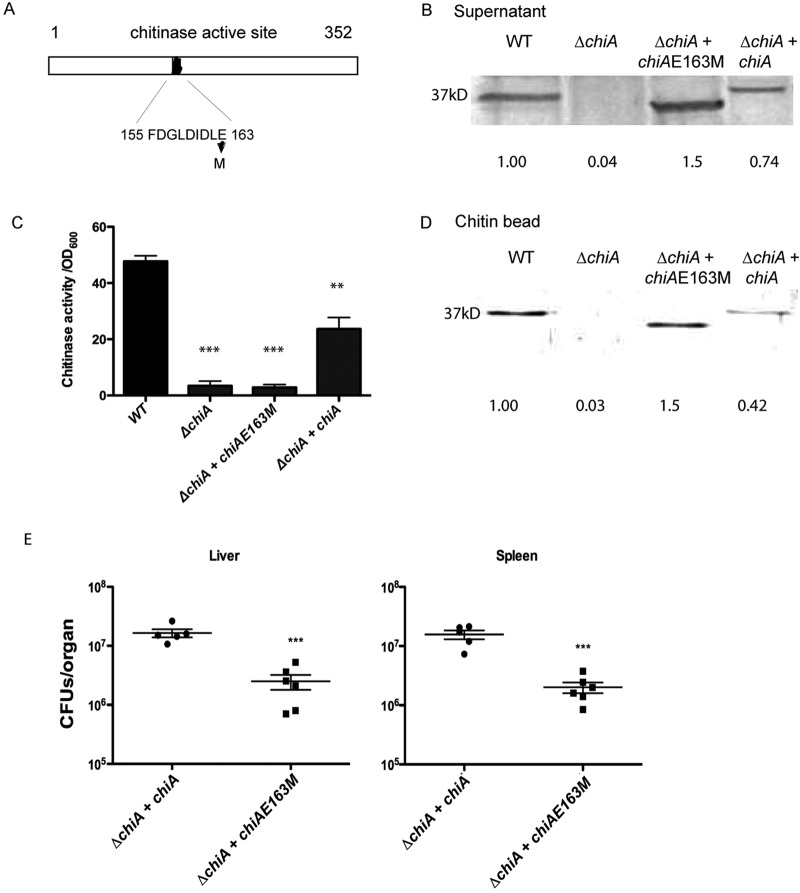FIG 3 .
ChiA chitinase activity appears to contribute to L. monocytogenes virulence. (A) Schematic diagram of ChiA showing the conserved region of 10 amino acids within the active site of the chitinase. The substitution of methionine (M) 163 for glutamate (E) has been demonstrated to eliminate chitinase activity without affecting chitin binding in other closely related ChiA family members (31). (B) Detection of secreted ChiA by Western blot analysis. Bacterial supernatant proteins from overnight cultures of wild-type, ΔchiA, ΔchiA + pPL2-chiA, and ΔchiA + pPL2-chiA E163M bacteria were isolated using trichloroacetic acid (TCA) precipitation. Sample volumes were adjusted to reflect equivalent bacterial cell densities. Secreted ChiA was detected using rabbit polyclonal antibody directed against ChiA. The amount of protein detected for each sample in comparison to that in the wild-type lane (set at 1.0) as determined by densitometry is indicated at the bottom of each panel. Data shown are representative of at least 3 independent experiments. (C) Assessment of chitinase activity in bacterial supernatants. Supernatants derived from overnight cultures of wild-type, ΔchiA, ΔchiA + pPL2-chiA, and ΔchiA + pPL2-chiA E163M were assessed for chitinase activity using the colorimetric substrate nitrophenyl N,N′--diacetyl-β-d-chitobioside. Chitinase activity was reflected by substrate hydrolysis as measured by absorbance at an optical density at 405 nm (OD405) as a function of bacterial cell density. Data shown represent the means ± standard errors for three independent experiments. Statistically significant differences as determined by one-way analysis of variance with Tukey’s multiple-comparison test are indicated (*, P < 0.01; **, P < 0.001; ***, P < 0.0001) (GraphPad V.5.0). (D) Detection of chitin binding by the ChiA wild-type and mutant proteins. Bacterial supernatants derived from overnight cultures of wild-type, ΔchiA, ΔchiA + pPL2-chiA, and ΔchiA + pPL2-chiA E163M bacteria were adjusted to control for equivalent cell densities, concentrated 50-fold, and incubated with chitin beads for 1 h at 4°C. Beads were washed with PBS, and bound protein was recovered following boiling of the beads in SDS-PAGE sample buffer. ChiA bound to chitin was detected by Western blot analysis using rabbit polyclonal antibody directed against ChiA. The amount of protein detected for each sample in comparison to that in the wild type lane (set at 1.0) as determined by densitometry is indicated at the bottom of each panel. Data shown are representative of at least 3 independent experiments. (E) Assessment of bacterial virulence in mice. Swiss Webster mice were intravenously infected with 2 × 104 CFU of either ΔchiA + pPL2-chiA or ΔchiA + pPL2-chiA E163M bacteria. The scatter plot shows CFU obtained from the livers and spleens of five individual mice at 72 h postinfection; the data are representative of two independent experiments. Solid lines and brackets represent the means and standard errors of the means, respectively, for the data points in each group. ***, statistically significant value (P < 0.0001) for ΔchiA + pPL2-chiA E163M results in both the liver and the spleen after 72 h of infection compared to ΔchiA + pPL2-chiA results using a one-way analysis of variance with Dunnett’s posttest (GraphPad V.5.0A).

